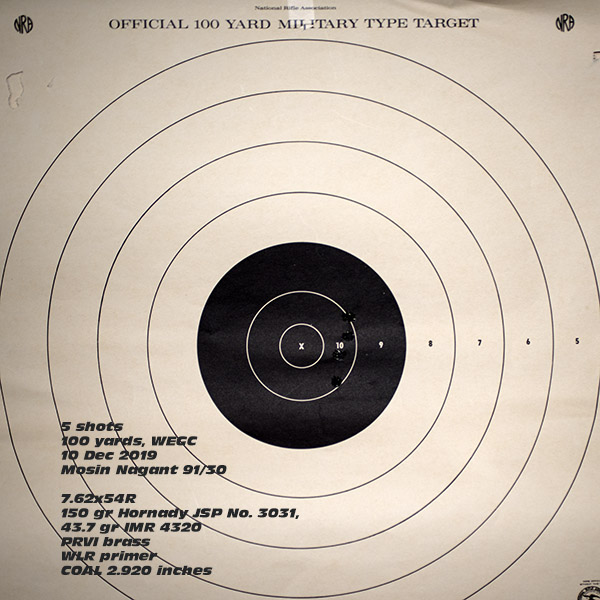I went to the range yesterday with two rifles, a Mosin-Nagant 91/30 and an M1 Garand. The Mosin was the Soviet Infantry’s standard rifle during World War II (it’s been around in various forms since 1891), and it’s one I’ve always enjoyed shooting. The Garand is a US weapon developed in the 1930s and first used by our troops in World War II. It is a semi-automatic rifle, which gave us a tremendous advantage over the enemy forces we fought (their rifles were bolt action).

I enjoy getting out to the range, and yesterday was a beautiful day. Sunny, cold, and not too windy. I shot on the 100-yard range, first with the Mosin and my standard load for that rifle.

After five shots, I put the Mosin away. It’s almost too easy with that rifle. I had a good target, I thought I would get a photo for the blog, and I was eager to try the Garand.
My Garand is kluge rifle assembled with parts from a series of mismatched manufacturers. The receiver is a CAI (considered to be of inferior quality to the ones made by the standard US suppliers Winchester, Harrington and Richardson, and Springfield Arsenal), the trigger group is from Beretta, and the barrel is a 1955 RSC (presumed to be Italian). I’ll state up front I don’t know a lot about Garands, and the reasons I bought this one (my first and only Garand) is I liked the finish, the price seemed right, and the money was burning a hole in my pocket that day.

Shooting the Garand well has been a challenge for me. I like shooting with iron sights, but I’m a post-and-slot guy. I haven’t had a ton of experience with aperture sights, and that’s taking some getting used to. Then there’s the issue of a decent load. I’ve been playing with different loads for the Garand, and I found three loads that work well. On my last outing, I had a few shots that were low left on the target outside the bullseye, and one of our readers asked if those shots were either the first or last shots from each clip. I didn’t know at the time because I shot each en bloc clip of 8 rounds without looking at the target after each shot.
My objective yesterday was to answer the above question, and sure enough, I did. My shots grouped well except for the first shot from each clip. I shot three clips (for a total of 24 rounds), and in each clip, the first shot hit low left.

The challenge now is to determine the reason why that first shot from each clip is going low. I posted the target you see above in a Garand group asking for input on why the first round from each clip went low, and as you might guess, the answers were all over the map. Most responses served only to illustrate that people don’t read very well, but a few were informative. A couple said their rifles behaved the same way and it was predictable enough (as is the case with mine) to allow for simply aiming high right for the first shot from each clip to put all 8 rounds in the black. One response suggested that the bolt may not be closing fully, as the first round is chambered by manually releasing the op rod, while all subsequent rounds are chambered when the action is cycled by the gun gases. I think that guy is on to something, and that will be where my future focus is going to be. If you have any ideas, I’d sure like to hear them. Leave a comment if you have the answer, and thanks in advance for any inputs.
Read our other Tales of the Gun!
